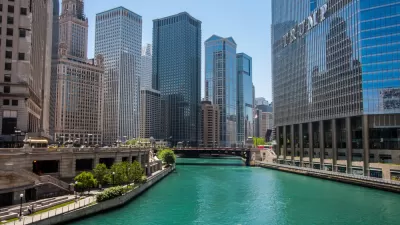Republican frontrunner Donald Trump has announced his plan to expand his branding if elected President of the United States in November.

Citing the quality of his signs and his desire to "piss off" Blair Kamin, the Pultizer Prize winning architecture critic for the Chicago Tribune, Donald Trump announced today that he's having his campaign staff look into opportunities for new locations to place "TRUMP" signs around Washington, D.C. when he's elected.
The idea was born out of a feud between Trump and Kamin, dating back to 2014, when a 2,891-square-foot sign bearing the word "Trump" was attached to the Trump International Hotel and Tower overlooking the Chicago River. In a review for the Tribune, Kamin called the sign "a poke in the eye."
Trump responded to the criticism by calling Kamin a "sucker" and a "bad critic." The whole episode caught the attention of Jon Stewart, while still with the Daily Show, in a segment humorously titled "Signfeud."
"I'm having my staff look at a few new locations for Trump signs in Washington, D.C.," said a noticeably smug Donald Trump to an appreciative audience at a campaign rally in Wisconsin today. "I can't decide if a new sign should go on the façade of the White House or on the North Lawn so it's easier to see in photos from Pennsylvania Avenue," added Trump. The Trump campaign staff released a statement later in the day that also listed the Rose Garden, the Oval Office, Air Force One, Marine One, and the roof of the White House (to be more visible from Marine One), as potential locations for new Trump signage.
FULL STORY: Trump Would Move Infamous Sign From Chicago to the White House If Elected

Planetizen Federal Action Tracker
A weekly monitor of how Trump’s orders and actions are impacting planners and planning in America.

Congressman Proposes Bill to Rename DC Metro “Trump Train”
The Make Autorail Great Again Act would withhold federal funding to the system until the Washington Metropolitan Area Transit Authority (WMATA), rebrands as the Washington Metropolitan Authority for Greater Access (WMAGA).

The Simple Legislative Tool Transforming Vacant Downtowns
In California, Michigan and Georgia, an easy win is bringing dollars — and delight — back to city centers.

The Small South Asian Republic Going all in on EVs
Thanks to one simple policy change less than five years ago, 65% of new cars in this Himalayan country are now electric.

DC Backpedals on Bike Lane Protection, Swaps Barriers for Paint
Citing aesthetic concerns, the city is removing the concrete barriers and flexposts that once separated Arizona Avenue cyclists from motor vehicles.

In These Cities, Most New Housing is Under 441 Square Feet
With loosened restrictions on “micro-housing,” tiny units now make up as much as 66% of newly constructed housing.
Urban Design for Planners 1: Software Tools
This six-course series explores essential urban design concepts using open source software and equips planners with the tools they need to participate fully in the urban design process.
Planning for Universal Design
Learn the tools for implementing Universal Design in planning regulations.
Smith Gee Studio
City of Charlotte
City of Camden Redevelopment Agency
City of Astoria
Transportation Research & Education Center (TREC) at Portland State University
US High Speed Rail Association
City of Camden Redevelopment Agency
Municipality of Princeton (NJ)



























